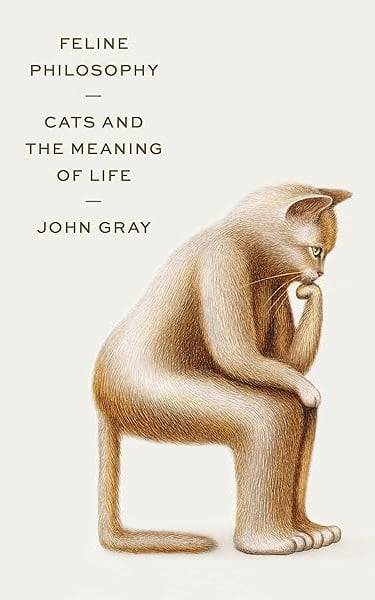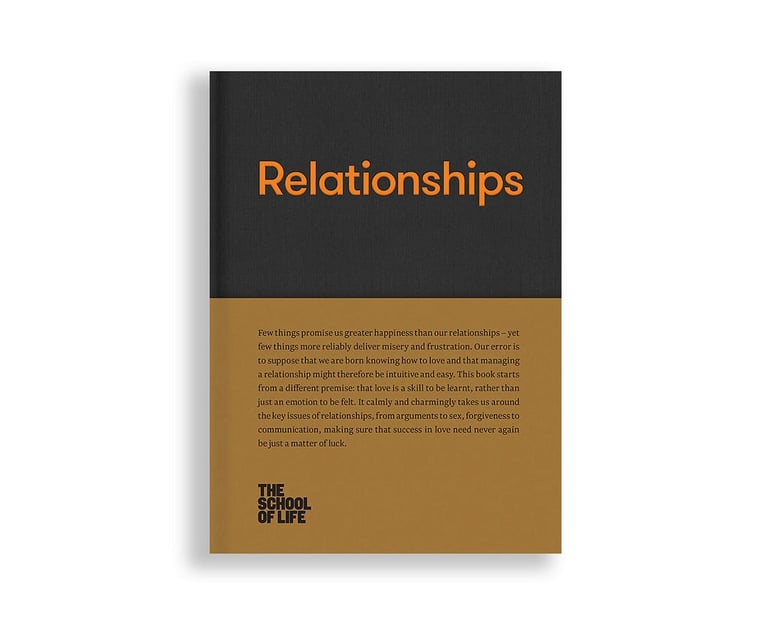Cats and the Meaning of Life
A summary and interpretation based on the book of the same name by John Gray.


One of the great secrets why cats are so much happier than humans lies in one word: contentment.
While the cat relaxes on a warm Sunday, enjoying the bright sun on the balcony, her owner in the background is once again in turmoil:
The phone is broken, and with a lukewarm cup of coffee, the human stares in frustration and boredom at the blank white wall in the living room.
The first thoughts arise, then more and more, until ultimately every life decision is questioned.
Am I actually happy? What fulfills me? Am I living according to my innermost convictions?
And thus begins the internal and usually uncomfortable monologue into the existential abyss of our psyche.
But if a person’s life goal is "to be happy", that implies a sense of incompleteness in the present moment.
Because this goal could only be reached in the future.
For reasons like these, people turn to philosophy to alleviate their present discomforts and find possible solutions to their problems.
Cats, on the other hand, don’t need philosophy to be happy – happiness for them is a state that matches their nature.
Cats are therefore happy simply being themselves, whereas humans try to become happy by escaping themselves.
So we can learn a lot from cats, for example that our pursuit of happiness is doomed to fail.
Why this is the case, I’ll explain in the next section.
What do cats have that we don't?
Well, for one thing, they have fur, and for another, they enjoy playing with their food (which, of course, cannot be ruled out for some humans either).
But upon closer inspection, one might realize that cats possess a distinctly independent character that, compared to dogs, is not unconditionally tied to humans.
Cats are certainly capable of living life on their own (four) feet – the best example of this are outdoor cats.
The Domestication of Humans
Although humans are known for having domesticated many animals, many are also firmly convinced that the same applies to cats. John Gray, however, sees it differently—he believes that cats domesticated humans. They voluntarily joined humans, as their alliance offered mutual benefits from early on: Cats protected grain stores by hunting pests. Thanks to human tolerance, cats gradually gained more space within towns and villages until we eventually came to consider them our pets. To this day, cats display strong independence in their daily behavior. Some even live semi-wild lives, free to come and go as they please.
Compared to dogs, cats always have a choice and could theoretically live on their own. Yet, many still choose their owners and train them—demanding food and affection on their own terms. Thus, while cats live alongside humans, they do so under their own conditions.
As Michel de Montaigne once wrote:
"When I play with my cat, who knows if I am not more of a pastime to her than she is to me?"
Happiness versus Unhappiness
Morality as a Happiness Killer
Moral concepts and expectations regarding one’s own personality accompany humans throughout life.
If we act in accordance with our own and others' moral expectations, this strengthens the sense of meaning in life.
But the downside appears especially when we break moral principles.
We feel filled with remorse and guilt, which make life more difficult.
Morality thus seems to be a man-made problem, because cats act far away from such moral ideas.
They have no ideals and don’t burden themselves with thoughts about right or wrong. Morality holds a value for us that is more important than many others.
Let’s compare this with an example:
On the street, a person finds a lost wallet and picks it up.
From a moral perspective, a conflict now arises and they ask themselves:
“Should I bring the wallet to the lost and found?” or
“Should I just pocket it – after all, no one saw me?”
Shaped by social norms and values – but also personal circumstances – the person’s behavior is evaluated morally. If the person returns the wallet, they will feel good – not only because they helped someone,
but because they stayed true to their own moral expectations. If they keep the wallet, the short-term gain may be tempting, but guilt might come back to haunt them later. The burden of having to make decisions, instead of ignoring them (as cats would), makes us either better or worse people. While animals are free from such inner conflicts, we carry this burden.
The way of the Dao
And this is exactly where philosophy comes in: Long before morality was assigned the high value it holds today, as we know it, there were other perspectives on a fulfilled life in ancient China.
The solution was Daoism, which focused on the flow of life or the way of the universe. This worldview did not place morality or certain principles at the center, as, for example, Stoicism does.
The meaning of life consisted rather in living with the nature one was given. To put it more simply: to live with what one has and who one is. The Dao is indeed associated with virtues,
but according to John Gray, these can also be seen as catalysts to help guide a life in harmony with things.
They are thus more of a guide for orientation rather than an overarching law.
To live in accordance with one’s given nature therefore means to be a Daoist.
Cats are thus born Daoists: They follow their own nature and do not get lost in contemplation or moral demands.
In Chinese, one also speaks of the usefulness of being useless (“wúyòng zhī wéi yòng”) or the principle of “free wandering” (“xiāoyáo yóu”).
Western philosophy changed the human self-image over the centuries. Traditional ancient philosophy taught people to live in harmony with nature. Today, modern approaches such as existentialism confront us with new challenges. They assign to humans the search for a deeper meaning, which must be found in order to be happy.
Animals do not live in pursuit of meaning – they simply are, unlike humans, who always try to shape their lives into a story.
John Gray`s view on Diversion
While cats radiate indifference, it is difficult for us, because of our self-image,
not to think about a meaningful design for our life. Because we are able to reflect on the past and imagine the future, we become aware of the fact that we will one day no longer exist. When we humans have an unplanned weekend ahead or days where we do nothing, it can sometimes feel as if we are wasting our precious time.
Cats just go hunting, play with each other, and sleep when they feel like it – and they don’t think about whether time is passing slowly or quickly. They have no inner restlessness forcing them into action. They don’t plan their lives – they just take things as they come. That’s why humanity tries to make complex life more bearable
through distractions (also called "diversion").
John Gray doesn’t only refer to distractions like our smartphones, but more so to the creation of artificial situations, to avoid thinking about our "misery", which we call life. We throw ourselves into a new romance and give up part of ourselves, or we travel to escape our worries. In antiquity, people tried to flee existential fears
through philosophy and religion, in search of possible answers.
To this day, there is no definitive answer to the question of what exactly makes our existence more bearable
and ultimately what makes us happy. There are only many approaches from Western and Eastern philosophy
that attempt to act as guides on the path to happiness. Stoicism revives desirable virtues and values that promise a good life. Daoism, on the other hand, rejects life according to written laws
and focuses much more on following the flow of life and letting everything come as it will.
Happiness, therefore, is a matter of interpretation.
Bonus Chapter: What About Love?
Love was not always love as we would define it today. Especially in the 18th and 19th centuries, love held a rather secondary importance, shaped by economic reasons (e.g., partnerships of convenience) and familial pressure. In the 18th century, the gradual romanticization of love began, introducing a new perspective on it. Concepts like soulmates, true love requires no effort, and love must be spontaneous and intense slowly shaped generations up to the present day.
At first glance, this idealization may sound positive, but it also carries significant risks: It creates unattainable expectations, as reality often looks very different. As Alain de Botton (from The School of Life) argues, he sees romance as a beautiful but dangerous fantasy—and the main reason why modern relationships fail.
With cats, love is entirely different. While our love is often shaped by expectations, ideals, and sometimes even self-deception, a cat's love is present and free from illusions. They love when they feel like it—and usually, only in the moment. Everyone knows that situation when you're relaxing on the couch in the evening, and the cat comes over to cuddle. Cats demand affection when they need it—but they also simply walk away when they want to. Even among themselves, cats don’t possess a sense of ownership; their love isn’t tied to any conditions. They show us: We should learn to love without holding on.
My final thoughts
To be a cat means to face life with equanimity. You take things as they come and act according to your own judgment, doing what you believe is right. The truth, however, is that we are not cats. Our self-reflective thoughts and actions often make life harder than it needs to be.
Yet, just as it is in a cat’s nature to contentedly enjoy the day, it is in our nature to overthink and seek meaning in our lives. This is the very trait that makes us fully human. It would not be right to abandon our "humanity" simply because life is too complex to be fully understood.
Still, there is much we can learn from our furry companions—and much we can apply to our own lives. For this reason, I’ve summarized (in my opinion) the most important lessons...

Stop chasing happiness, because as long as you do, you won’t find it.
Instead, focus on doing what brings you joy right now.
Manfred

Practice loving people without clinging or trying to possess them.
A cat’s love is voluntary, situational, and not oriented toward the future.
Friedolin

Don’t turn your life into a story you want to tell at the end.
Your past does not define your future — live in the here and now.

Fiona
Here are some book recommandations based on this topic:




